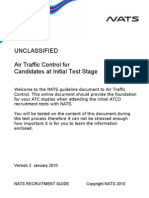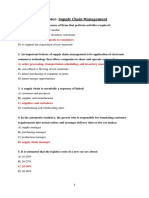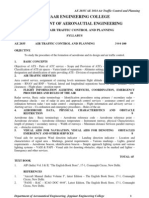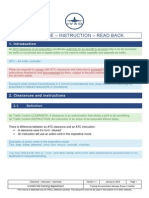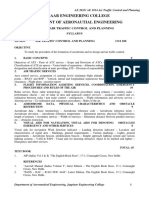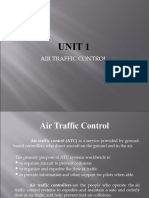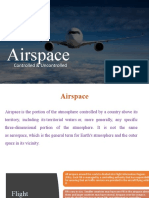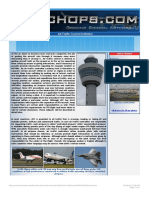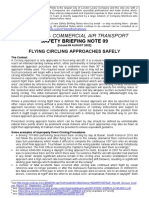UK Flight Information Services: Guidance From The Civil Aviation Authority July 2016
UK Flight Information Services: Guidance From The Civil Aviation Authority July 2016
Uploaded by
Flappy BirdCopyright:
Available Formats
UK Flight Information Services: Guidance From The Civil Aviation Authority July 2016
UK Flight Information Services: Guidance From The Civil Aviation Authority July 2016
Uploaded by
Flappy BirdOriginal Description:
Original Title
Copyright
Available Formats
Share this document
Did you find this document useful?
Is this content inappropriate?
Copyright:
Available Formats
UK Flight Information Services: Guidance From The Civil Aviation Authority July 2016
UK Flight Information Services: Guidance From The Civil Aviation Authority July 2016
Uploaded by
Flappy BirdCopyright:
Available Formats
UK Flight Information Services
Guidance from the Civil Aviation Authority July 2016
Introduction
The purpose of this leaflet is to provide guidance to pilots on the types of Air Traffic Service (ATS) that are available
within Class E and G airspace1 (see UK AIP ENR 1.4 for explanations of the airspace classifications and where they
are established) in the UK Flight Information Regions (FIRs). These ATS are provided in accordance with CAP 774
UK Flight Information Services (UK FIS), which explains in detail the ATS available in Class G airspace and, where
specified, Class E airspace. The UK FIS comprise the following ATS:
Basic Service.
Traffic Service.
Deconfliction Service.
Procedural Service.
The ATS are intended to cater for a wide variety of airspace users and aerial tasks and it is the pilot of an aircraft who
must choose the service that they require. It is essential that the service requested is appropriate both for the type of
flight that is being undertaken and the meteorological conditions that are expected. Pilots should bear in mind that
some ATS units (ATSU) are staffed by Flight Information Service Officers2 (FISOs) and as such will ONLY be able to
provide a Basic Service. Traffic Service and Deconfliction Service are provided subject to ATC workload and
other constraints and are not guaranteed to be available. This should be considered when planning the flight.
The basis of the UK FIS are that all pilots, air traffic controllers (ATCO) and FISOs understand what each of the
services can provide to pilots and, perhaps more importantly, understand what they do not provide. In providing any of
the UK FIS, an ATSU can only provide assistance - pilots are always responsible for collision avoidance and terrain
clearance. It is essential to remember that an ATS is not intended to replace pre-flight planning, nor is it a
comprehensive source of information on the presence of other aircraft.
It is vital that pilots understand the benefits and limitations of the available ATS, in order to be able to ask an ATSU for
the one that is best suited to their requirements. In other words, always ask for the level of service appropriate to
actual need and be prepared to consider the implications on the flight if that service is not available.
1
Safety Sense Leaflet 27 provides advice concerning flight inside controlled airspace.
2
FISOs provide advice and information to pilots that is useful for the safe and efficient conduct of flight. In addition, in granting or refusing permission
under Rules 12 and 13 of the Rules of the Air Regulations 2015, Aerodrome FISOs are permitted to pass instructions to vehicles and personnel
operating on the manoeuvring area.
In Focus | July 2016 | CAP1434 www.caa.co.uk
The UK FIS are designed to balance the provision of advice and information provided to pilots, in order to assist them
in safely achieving the objectives of the flight.
When operating VFR and only in need of information on general airspace activity, local altimeter settings,
etc, then it’s likely that a Basic Service will be appropriate.
If operating IFR in IMC and 'see and avoid' principles may be difficult or impossible to apply and assistance
from ATC is required to deconflict you from other aircraft in your vicinity, then it’s likely that a Deconfliction
Service will be appropriate. This is the only surveillance-based UK FIS where a controller will provide you
with this type of advice.
Traffic Service may be requested under VFR or IFR where surveillance based information from ATC on
other traffic is sufficient to help to avoid other traffic visually.
Basic Service
A Basic Service is intended to offer the pilot maximum autonomy and is available to IFR
flights in Class G airspace, or VFR flights in Class E and Class G airspace. If the ATCO or
FISO are aware of airspace activity that may affect your flight they will tell you; however, this
is subject to their workload and the avoidance of other traffic is solely the pilot’s
responsibility. Maintain a good lookout.
Traffic Service
Under a Traffic Service, an ATCO will use radar to provide you with detailed traffic
information on specific conflicting aircraft; they will not provide you with deconfliction advice,
regardless of your meteorological conditions. A Traffic Service is available to IFR flights in
Class G airspace, or VFR flights in Class E and Class G airspace.
Deconfliction Service
Only available to IFR flights in Class G airspace. An ATCO will use radar to provide you with
detailed traffic information on specific conflicting aircraft AND advice on how to avoid that
aircraft. However, the pilot retains responsibility for collision avoidance; you can opt not to
follow the ATCO’s advice.
Procedural Service
Only available to IFR flights. A non-surveillance service in which deconfliction advice is
provided against other aircraft in receipt of a Procedural Service from the same ATCO; the
ATCO will not be aware of any other aircraft. The pilot is responsible for collision avoidance.
Maintain a good lookout.
In Focus | July 2016 | CAP1434 www.caa.co.uk
Manoeuvring
Basic Service
You are free to manoeuvre laterally and vertically unless you have agreed with a specific limitation with ATC
in order to allow them to coordinate you against other aircraft. For example, to fly not above a particular
altitude, or remain north of a specified line feature.
Traffic Service
ATC will expect you to fly in accordance with the details you have passed them. You should not change from
this, or from any agreed heading or level/level block, without first advising ATC AND obtaining a response
from them; they may be coordinating your flight against other aircraft, based on their ability to predict where
you’re going.
Deconfliction and Procedural Service
ATC will expect you to fly in accordance with the details you have passed them. You may not change your
heading or level without the approval of ATC; they may be coordinating and deconflicting your flight against
other aircraft, based on their ability to predict where you’re going.
Traffic information
The purpose of traffic information is to assist you to visually acquire other traffic by providing you with:
The position and movement of conflicting aircraft in relation to you.
The vertical position of conflicting aircraft.
The apparent horizontal and vertical speed of conflicting aircraft, where relevant.
The conflicting aircraft type, if known and considered relevant.
The terms used to describe the conflicting aircraft’s relative movement have specific meaning and it is important that
you understand this in order to plan your reaction to the information. The terms most often used by ATC are:
Crossing
Used to describe the relative movement between your
aircraft and the conflicting traffic.
ATC will describe the relative direction of movement
either “left to right” or “right to left” and should include the
words “ahead” or “behind” where appropriate, to assist
you in assessing the conflicting aircraft’s flight path.
In Focus | July 2016 | CAP1434 www.caa.co.uk
Opposite direction
Used to describe where the flight path of the conflicting
aircraft is approximately 180° opposed to that of your
flight path but is not necessarily converging.
Converging
Used to describe where there is no relative movement
between your aircraft and the conflicting traffic and/or
ATC perceives there to be a significant risk of mid-air
collision. This type of conflict is the hardest to spot
because the human eye is better at detecting moving
rather than stationary targets. The conflicting aircraft
may appear, at least initially, to be a black dot that is
not moving on the canopy.
Avoiding action
Under Basic Service or Traffic Service, where traffic information includes the term “converging”, you need to act
quickly to visually acquire the conflicting aircraft and to decide on a course of action.
It can take a significant amount of time to visually acquire a conflicting aircraft, identify whether the aircraft poses a
threat and to then respond to that threat. Consider also that, if having received traffic information you request a
Deconfliction Service in order to receive deconfliction advice, ATC needs enough time to assess the situation, make a
decision and provide you with that advice. Remember also that you will need enough time to then process and react to
that advice. In short, plan ahead and select an ATS that is appropriate for your phase of flight and
meteorological conditions and keep this under review throughout your flight.
Terrain and obstacle clearance
Pilots are always responsible for providing their own terrain and obstacle clearance whilst flying outside controlled
airspace. However, ATC will only provide a Deconfliction Service, or vectors to pilots in receipt of a Traffic Service, at
levels which they consider to be terrain safe.
In Focus | July 2016 | CAP1434 www.caa.co.uk
Radar service limitations
Unknown traffic may make unpredictable or high-energy manoeuvres and some aircraft, for example gliders,
microlights, balloons and very slow moving aircraft do not always show on radar. When they do, they are often
indistinguishable from the radar returns of, say, birds or even road vehicles. Moreover, some radar only show aircraft
with transponders. As a result, it is vitally important to maintain the best possible look-out for other aircraft,
even when receiving a radar service.
A radar service can be adversely affected by other factors – such as radar clutter, poor radar performance, high traffic
density and controller workload – which may mean that traffic information or deconfliction advice is less accurate, late
or absent. In these circumstances, ATC will usually give specific warnings of the situation, e.g. “reduced traffic
information due radar coverage”. You should note the warning and conduct your flight accordingly – for example,
adjust your look-out scan, or perhaps change your route or level to provide greater separation from the problem area.
Occasionally however, the controller may have to offer an alternative service.
How to obtain a service
You should contact the appropriate ATSU and ask for the service you require. The controller or FISO will tell you
whether your request can be met. You can request a change in the type of service at any time. Having established 2-
way RT with the unit and been advised to “pass your message”, the following information is to be passed:
Callsign and type of aircraft
Departure and destination airfields
Estimated position
Level (or level band for traffic carrying out general handling)
Flight rules (IFR/VFR)
Intentions (next reporting/turning point or general handling area)
ATC will make all reasonable endeavours to provide the type of service that you require; however, there are times
when this may not be possible due to the volume of traffic already in receipt of a service from the unit, individual
controller workload, equipment serviceability etc. In such cases, ATC may 'reduce' the provision of traffic information
and/or deconfliction advice, or may offer the next most appropriate level of service available.
Even when providing a Basic Service, ATC may wish to identify your aircraft on radar to confirm your position and may
also allocate you a transponder code – but be aware that neither of these means that you are receiving any type of
radar service. ATC may wish, for example, to be able to pass traffic information on you, to another aircraft that is
receiving an ATS.
Once an ATS has been agreed, it is important to bear in mind that as the flight progresses and changing weather
conditions are experienced, the choice of service may need to be re-considered. For example, a Basic Service or a
Traffic Service might not be appropriate for flight in IMC, or where lookout is constrained by other factors, when other
ATS are available. The relationship between weather expectations and the availability of the UK FIS need to be
considered during pre-flight planning.
In Focus | July 2016 | CAP1434 www.caa.co.uk
Availability of services
Any ATSU may provide the services described in this leaflet3 but you should particularly note the following:
Lower Airspace Radar Service
Specific ATSUs within the UK participate in a system called the Lower Airspace Radar Service (LARS). The location of
these units makes them particularly suitable for providing an ATS to transit traffic at and below FL 95 and are generally
available on weekdays 0800 to 1700 local. It’s important to know that the LARS is just the system of units and not the
service itself; the LARS units provide UK FIS. Details of the LARS can be found in the UK AIP at ENR 1.6.3, with the
participating units and their area of responsibility shown in a chart at ENR 6.1.6.3.
Area Control Centre (ACC) Flight Information Service
The London and Prestwick ACCs provide UK FIS within their respective areas of responsibility, as shown in the charts
at UK AIP ENR 6-2-0-1 and 6-2-0-2. FISOs use the callsign “Scottish Information” or “London Information” and provide
Basic Service only. Traffic Service and Deconfliction Service are available from controllers at the Prestwick ACC in
many parts of the Scottish FIR, subject to controller workload. You should consider a call if you have not obtained an
ATS elsewhere and note that the service for the whole London FIR may be operated by one person. Although a
transponder code may be allocated by a FISO, no radar service will be provided.
Military Aerodrome Traffic Zone (MATZ) Penetration service
This is available for military aerodromes which have a MATZ. The service will often include provision of a radar
service. Details are in the UK AIP at ENR 2.2.2 and contact frequencies are shown on the CAA 1:500 000 and 1:250
000 VFR charts. SafetySense Leaflet 26 contains guidance for visiting or flying near military aerodromes.
Other radar service providers
The UK FIS may also be provided by other civil or military providers in certain areas, including around certain Control
Zones and Control Areas and under TMAs.
Danger Area Services
Nominated ATSUs (see UK AIP ENR 5.1.3 and the legend on the CAA 1:500 000 and 1:250 000 VFR charts) may
provide a Danger Area Crossing Service (DACS) (annotated '†' against contact frequencies) or a Danger Area Activity
Information Service (DAAIS) (annotated '§' against frequencies). DACS may also be available by telephone
(annotated against contact numbers frequencies). MERELY OBTAINING INFORMATION UNDER DAAIS DOES
NOT GIVE A CLEARANCE TO CROSS AN ACTIVE DANGER AREA. THE CONTROLLING UNIT MUST
HAVE GIVEN YOU A SPECIFIC CLEARANCE TO ENTER IT.
Leaving the frequency
When you wish to change to another frequency, always tell the FISO/Controller that you are leaving their frequency
and your subsequent intentions. Set SSR code 7000 or appropriate transponder code with the ‘altitude’ function (if
available) selected.
3
Pilots should bear in mind that some ATSU are staffed by FISOs and as such will ONLY be able to provide a Basic Service.
In Focus | July 2016 | CAP1434 www.caa.co.uk
Frequency monitoring codes
Within the UK, specific frequency monitoring SSR codes (more popularly known as ‘listening out’ squawks) have been
established for pilots to use when operating in the vicinity of certain areas of controlled airspace (see UK AIP ENR
1.6.2.2.5). Pilots monitoring these frequencies but who do not require an ATS should select the specified SSR code
with altitude (if available) to indicate that they are monitoring the promulgated ATC frequency. This allows ATC to
attempt to establish contact with an aircraft which is displaying such a code and which is considered to be infringing, or
is likely to infringe, controlled airspace. Selection of these codes does not imply the provision of any form of ATS and
their use does not prevent a pilot from requesting a service at any time.
Summary
It is essential to remember that an ATS is not intended to replace pre-flight planning, nor is it intended to be a
comprehensive source of information on the presence of other aircraft. It is vital that pilots understand the benefits and
limitations of the available UK FIS. Plan ahead and select the service that is appropriate for your phase of flight and
meteorological conditions and amend your choice of ATS and/or your flight itself to suit the changing circumstances.
Resources
UK Flight Information Services (CAP 774)
The UK Flight Information Services (CAP 774) details the suite of air traffic services which (excluding aerodrome
services) are the only services provided in Class G airspace within the UK Flight Information Region (Where notified,
elements of the UK FIS are also provided to aircraft operating in Class E airspace). Therefore, this document is equally
applicable to all civilian and military pilots, air traffic controllers, and Flight Information Service Officers.
Radiotelephony Manual (CAP 413)
The UK Radiotelephony Manual (CAP 413) aims to provide pilots, Air Traffic Services personnel and aerodrome
drivers with a compendium of clear, concise, standard phraseology and associated guidance for radiotelephony
communication in United Kingdom airspace.
CAA document search
NATS Aeronautical Information Service
UK Integrated Aeronautical Information Package
UK AIP GEN
UK AIP ENR
Aeronautical Information Circulars
NOTAMS
VFR chart updates
Airspace & Safety Initiative
The Airspace & Safety Initiative (ASI) is a joint CAA, NATS, AOA, GA and MoD project to investigate and tackle the
major safety risks in UK airspace. The initiative aims to encourage good practice for all pilots, to help reduce airspace
incidents such as infringements of controlled airspace.
Flyontrack
An independent website for private pilots, covering airspace infringement issues. The site is run on behalf of GASCo
and is part of the Airspace & Safety Initiative.
In Focus | July 2016 | CAP1434 www.caa.co.uk
You might also like
- Air Navigation FacilitiesDocument8 pagesAir Navigation FacilitiesrutherenceNo ratings yet
- NATS Test MaterialsDocument25 pagesNATS Test Materials1NessaNo ratings yet
- Instrument Flying Handbook (2025): FAA-H-8083-15BFrom EverandInstrument Flying Handbook (2025): FAA-H-8083-15BRating: 4 out of 5 stars4/5 (4)
- MCQ SCMDocument22 pagesMCQ SCMdebasri_chatterjee86% (7)
- Asp - Unit - 5Document9 pagesAsp - Unit - 5Deyoof Njm njmNo ratings yet
- Section A10 Operations outside Controlled AirspaceDocument4 pagesSection A10 Operations outside Controlled AirspacegregorpilotNo ratings yet
- PP ADC Clearance ReadbackDocument6 pagesPP ADC Clearance ReadbackChan WongNo ratings yet
- Guide To Visual Flight Rules (VFR) in The UK: Airspaceregulation@caa - Co.ukDocument42 pagesGuide To Visual Flight Rules (VFR) in The UK: Airspaceregulation@caa - Co.ukpedatiNo ratings yet
- Ae 2035-QBDocument127 pagesAe 2035-QBdennyfrancis19100% (1)
- Proper Training: Class A. Class B. Class CDocument2 pagesProper Training: Class A. Class B. Class CSiva KumarNo ratings yet
- 16 138BKT Airside Drivers Guide Runway Safety WEB 1Document32 pages16 138BKT Airside Drivers Guide Runway Safety WEB 1Rafiaa Al SharafNo ratings yet
- PP ADC Clearance ReadbackDocument6 pagesPP ADC Clearance ReadbackAlex KononenkoNo ratings yet
- Appendix D Flight Crew Best Practices: European Action Plan For The Prevention of Runway Incursions - Edition 2.0Document9 pagesAppendix D Flight Crew Best Practices: European Action Plan For The Prevention of Runway Incursions - Edition 2.0totololo78No ratings yet
- Ae 2035 QB PDFDocument127 pagesAe 2035 QB PDFSêlvâkûmâr JayabalaNo ratings yet
- Air Traffic Services Outside Controlled Airspace: Afety Ense LeafletDocument6 pagesAir Traffic Services Outside Controlled Airspace: Afety Ense LeafletSyed RahmanNo ratings yet
- Atplmax Ebook AirlawDocument32 pagesAtplmax Ebook AirlawShri RamNo ratings yet
- 5 Rac eDocument174 pages5 Rac erenebavardNo ratings yet
- Atc 2 MarkDocument21 pagesAtc 2 MarkJessica CarterNo ratings yet
- Air Traffic ServicesDocument3 pagesAir Traffic ServicesFluuxNo ratings yet
- Ch-10 - IfR FlightDocument34 pagesCh-10 - IfR FlightFahmi Prayogi100% (1)
- ATCDocument25 pagesATCVigneshVickeyNo ratings yet
- APPI Pilot Manual LegislationDocument9 pagesAPPI Pilot Manual Legislationsasha_saleNo ratings yet
- Ott 999 0092 18 00Document21 pagesOtt 999 0092 18 00cristidona100% (1)
- Controlled & Uncontrolled AirspaceDocument30 pagesControlled & Uncontrolled AirspaceShabrish Shabri100% (1)
- Airport and AirwaysDocument77 pagesAirport and Airwaysrigelzaki.araizNo ratings yet
- Wa0007.Document25 pagesWa0007.ThejeshwarrNo ratings yet
- AtcDocument48 pagesAtcfrancis GodoyNo ratings yet
- 1 Ch1bc-ATC-18nov2015Document36 pages1 Ch1bc-ATC-18nov2015vijay273017No ratings yet
- Runway Safety Best Practices BrochureDocument25 pagesRunway Safety Best Practices BrochureMo AllNo ratings yet
- Controlled and Uncontrolled AirspaceDocument26 pagesControlled and Uncontrolled AirspaceShabrish ShabriNo ratings yet
- TGM For Implemention of Apron Management ServicesDocument6 pagesTGM For Implemention of Apron Management ServicesanNo ratings yet
- Air Traffic Control & Airport Design Unit - 1Document50 pagesAir Traffic Control & Airport Design Unit - 1Prof L. OblisamyNo ratings yet
- SAFO20011 - Perations in Oceanic Airspace During The COVID-19 Public Health EmergencyDocument3 pagesSAFO20011 - Perations in Oceanic Airspace During The COVID-19 Public Health EmergencyDimitris SarmasNo ratings yet
- FON Aircraft TrackingDocument6 pagesFON Aircraft TrackingAndrey KarimovNo ratings yet
- Working With Aircraft CAP ModuleDocument15 pagesWorking With Aircraft CAP ModulewaynefishingNo ratings yet
- Air Traffic ControlDocument27 pagesAir Traffic ControlVinoth ParamananthamNo ratings yet
- Atc PDFDocument17 pagesAtc PDFNick AvisNo ratings yet
- What Can We Learn: Any Unauthorized Copying, Reproduction, Modification and Distribution of This Document Is ProhibitedDocument21 pagesWhat Can We Learn: Any Unauthorized Copying, Reproduction, Modification and Distribution of This Document Is ProhibitedyongdalaiNo ratings yet
- Air Traffic Control (ATC) - DutchOps - Com Powered PDFDocument2 pagesAir Traffic Control (ATC) - DutchOps - Com Powered PDFLaugh GeneratorNo ratings yet
- (3-9) .10.2016 Runway Incursions - Flight Crew Best PracticesDocument9 pages(3-9) .10.2016 Runway Incursions - Flight Crew Best PracticesA.T. DervisNo ratings yet
- VFR Flight Plan BasicsDocument11 pagesVFR Flight Plan BasicsAviNo ratings yet
- Communications A Key ComponentDocument28 pagesCommunications A Key ComponentCarlos Panao100% (1)
- Technical Centre, Opp. Safdarjung Airport, New Delhi Air Safety Circular 04 of 2014Document3 pagesTechnical Centre, Opp. Safdarjung Airport, New Delhi Air Safety Circular 04 of 2014amvitaNo ratings yet
- Bba AviationDocument45 pagesBba Aviationmanaswini sharma B.G.No ratings yet
- Ressumen Aviation Communication - pdf#2Document5 pagesRessumen Aviation Communication - pdf#2brandonginettNo ratings yet
- airlspace management in pakDocument4 pagesairlspace management in pakuclothouseNo ratings yet
- PP ADC Airspace StructureDocument7 pagesPP ADC Airspace StructureAlex KononenkoNo ratings yet
- Atc Unit-1 NotesDocument19 pagesAtc Unit-1 Notesashok pandiyanNo ratings yet
- Communication Failure ProcedureDocument6 pagesCommunication Failure Procedureeak_ya5875No ratings yet
- Say Again ResumenDocument24 pagesSay Again ResumenDylan CarrascoNo ratings yet
- How Aircrafts Are Controlled by Ground StationDocument2 pagesHow Aircrafts Are Controlled by Ground StationElvor eskanNo ratings yet
- OpDocument29 pagesOpGhino San DiegoNo ratings yet
- Mid-Air CollisionDocument2 pagesMid-Air Collisionthe_govNo ratings yet
- Air Pilots - Commercial Air Transport: Safety Briefing Note 09Document2 pagesAir Pilots - Commercial Air Transport: Safety Briefing Note 09özgür TanriverdiNo ratings yet
- OperationsDocument10 pagesOperationsPedro picapiedraNo ratings yet
- Doc9863 ACAS Pilot Training Chp5 1Document19 pagesDoc9863 ACAS Pilot Training Chp5 1Miftah Cayank Chinta DewikuNo ratings yet
- Minimum Facilities at The Helicopter Landing Sites ComplianceDocument4 pagesMinimum Facilities at The Helicopter Landing Sites ComplianceMukund PatilNo ratings yet
- Flight Navigation Aids for the Professional Pilot: Aviation Books Series, #18From EverandFlight Navigation Aids for the Professional Pilot: Aviation Books Series, #18No ratings yet
- 2015 Chevrolet JumboDocument4 pages2015 Chevrolet JumboAhmed Emad AhmedNo ratings yet
- Literature Review On Automobile Industry in IndiaDocument4 pagesLiterature Review On Automobile Industry in Indiaea59j0hqNo ratings yet
- Appendix 3 - Strategic Transport Projects (Planned/ Ongoing) HighwaysDocument8 pagesAppendix 3 - Strategic Transport Projects (Planned/ Ongoing) HighwaysSachindra KumarNo ratings yet
- Tabela Aplicações Velas LucasDocument2 pagesTabela Aplicações Velas LucasRenatoNo ratings yet
- Laws, Issuance of Licenses/ Permits and Fines/penalties For Violations of Land Transportation LawsDocument9 pagesLaws, Issuance of Licenses/ Permits and Fines/penalties For Violations of Land Transportation LawsMarvin ArriolaNo ratings yet
- Practical Test Standard (FAA S 8081 5)Document82 pagesPractical Test Standard (FAA S 8081 5)Justin100% (1)
- Projectreportofvocationaltrainingat 180805190331Document36 pagesProjectreportofvocationaltrainingat 180805190331Sachin GautamNo ratings yet
- A330 Fcom Rev02 30mar12Document3,566 pagesA330 Fcom Rev02 30mar122kgmr4ggypNo ratings yet
- Bulk CarriersDocument1 pageBulk CarriersMarco Di Palma100% (1)
- New Holland T7: I I I I I I I IDocument28 pagesNew Holland T7: I I I I I I I ILKKNo ratings yet
- 2017 SorentoDocument11 pages2017 SorentoNader aliNo ratings yet
- DGCA Headquarters:: S. N. Designated CPIO S/Sh. Telephone No. Subject Matter in Brief First Appellate AuthorityDocument4 pagesDGCA Headquarters:: S. N. Designated CPIO S/Sh. Telephone No. Subject Matter in Brief First Appellate Authoritysatvik chauhanNo ratings yet
- Maintenance Manual For Wagons PDFDocument460 pagesMaintenance Manual For Wagons PDFManish Verma100% (1)
- Agri King 20-55 - Agri King TractorsDocument5 pagesAgri King 20-55 - Agri King Tractorsnew launchNo ratings yet
- Sampa - BPWDocument44 pagesSampa - BPWЮрий ЛецкоNo ratings yet
- Application: Product DetailsDocument1 pageApplication: Product DetailsImran MehboobNo ratings yet
- LPTRPM Module 7 Network Analysis Rev2 20180328Document16 pagesLPTRPM Module 7 Network Analysis Rev2 20180328Hugo LabastidaNo ratings yet
- CHAPTER 5 (05:02) : Flexible Pavement DesignDocument43 pagesCHAPTER 5 (05:02) : Flexible Pavement DesignMuhd FareezNo ratings yet
- Design Analysis: A Critical Analysis of The Kr-2Document5 pagesDesign Analysis: A Critical Analysis of The Kr-2gadorchaNo ratings yet
- Motor QuotationDocument4 pagesMotor QuotationYogesh KhemaniNo ratings yet
- BP Guidelines Safe Working at Height in Logistics and Allied SectorsDocument24 pagesBP Guidelines Safe Working at Height in Logistics and Allied Sectorsnqh2009No ratings yet
- A318/A319/A320/A321: Service BulletinDocument23 pagesA318/A319/A320/A321: Service BulletinPradeep K sNo ratings yet
- Vessel Planning ConsiderationsDocument32 pagesVessel Planning ConsiderationsDajhanis GonzalezNo ratings yet
- Rule: Airworthiness Directives: CessnaDocument6 pagesRule: Airworthiness Directives: CessnaJustia.comNo ratings yet
- Airfield LightingDocument1 pageAirfield LightingBabblinbrooke44100% (1)
- Title: Automotive Powertrain Date: Objective: To Understand The Power Train Components of Automobiles Both Observation/TheoryDocument17 pagesTitle: Automotive Powertrain Date: Objective: To Understand The Power Train Components of Automobiles Both Observation/TheorybroNo ratings yet
- All New Price GuideDocument27 pagesAll New Price Guideagozalez.eymNo ratings yet
- 06 Road WriteUp 2022Document30 pages06 Road WriteUp 2022Silendrina MishaNo ratings yet
- Xl6 Price List: Must HaveDocument1 pageXl6 Price List: Must HaveanandNo ratings yet

